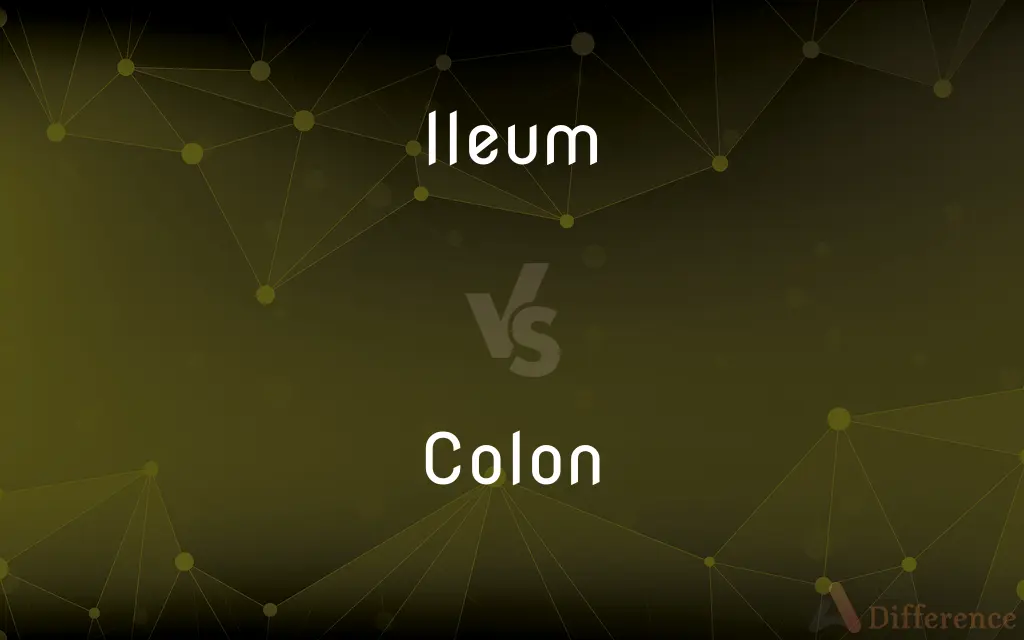Ileum vs. Colon — What's the Difference?
Edited by Tayyaba Rehman — By Fiza Rafique — Updated on April 23, 2024
Ileum absorbs nutrients and passes waste to the colon, which reabsorbs water and forms stool.

Difference Between Ileum and Colon
Table of Contents
ADVERTISEMENT
Key Differences
The ileum is the third and final part of the small intestine, primarily responsible for absorbing nutrients from digested food. In contrast, the colon, or large intestine, focuses on reabsorbing water and electrolytes from waste material.
The ileum has a highly specialized lining with villi and microvilli that increase surface area for absorption. On the other hand, the colon has a smoother lining designed to facilitate the transit of waste.
Digestive enzymes and bile are active in the ileum, aiding in the final stages of digesting proteins, fats, and carbohydrates. Whereas, the colon hosts a large microbial population that plays a crucial role in fermenting unabsorbed material.
The ileum plays a critical role in the immune system by containing numerous Peyer's patches, which monitor intestinal bacteria levels and prevent infection. Conversely, the colon primarily serves to compact waste into feces, with less involvement in immune functions.
The environment in the ileum is slightly acidic due to the presence of bile acids, enhancing nutrient absorption. In contrast, the environment in the colon is more neutral to slightly alkaline, which helps in bacterial fermentation.
ADVERTISEMENT
Comparison Chart
Function
Absorbs nutrients
Reabsorbs water, forms stool
Lining
Villi and microvilli
Smoother, lacks villi
Digestive role
Enzymatic digestion continues
Fermentation by bacteria
Immune role
Contains Peyer's patches
Less involvement in immunity
PH Environment
Slightly acidic
Neutral to slightly alkaline
Compare with Definitions
Ileum
Characterized by the presence of Peyer's patches.
The ileum's Peyer's patches are vital for regulating intestinal immunity.
Colon
Major part of the large intestine, extending from the cecum to the rectum.
The colon reabsorbs fluids and processes waste products and bacteria.
Ileum
Terminal part of the small intestine between the jejunum and the cecum.
The ileum plays a crucial role in the absorption of vitamin B12 and bile salts.
Colon
Has a broader diameter than the small intestine.
The colon's larger diameter allows it to store fecal material until expulsion.
Ileum
Site for the absorption of most nutrients from digested food.
After leaving the stomach, food passes through the ileum where nutrients are absorbed.
Colon
Absorbs water, sodium, and some fatty acids.
Water reabsorption in the colon is crucial for maintaining hydration.
Ileum
Contributes to maintaining gut flora balance.
The ileum also plays a role in housing beneficial bacteria that aid digestion.
Colon
Compacts waste into feces.
By the time material reaches the colon, it's mostly waste ready to be excreted.
Ileum
Contains villi and microvilli to increase surface area.
Nutrients are efficiently absorbed through the ileum's extensive villous lining.
Colon
Contains bacteria that ferment unabsorbed dietary residues.
Bacterial fermentation in the colon produces essential vitamins like vitamin K.
Ileum
The ileum () is the final section of the small intestine in most higher vertebrates, including mammals, reptiles, and birds. In fish, the divisions of the small intestine are not as clear and the terms posterior intestine or distal intestine may be used instead of ileum.
Colon
A punctuation mark (
) used after a word introducing a quotation, explanation, example, or series and often after the salutation of a business letter.
Ileum
The third portion of the small intestine, between the jejunum and the caecum.
Colon
The sign (
) used between numbers or groups of numbers in expressions of time (2:30 AM) and ratios (1:2).
Ileum
The terminal portion of the small intestine extending from the jejunum to the cecum.
Colon
A section of a metrical period in quantitative verse, consisting of two to six feet and in Latin verse having one principal accent.
Ileum
(anatomy) The last, and usually the longest, division of the small intestine; the part between the jejunum and large intestine.
Colon
An analogous unit or division of classical Greek or Latin prose.
Ileum
The last, and usually the longest, division of the small intestine; the part between the jejunum and large intestine.
Colon
The section of the large intestine extending from the cecum to the rectum.
Ileum
See Ilium.
Colon
See Table at currency.
Ileum
The part of the small intestine between the jejunum and the cecum
Colon
The punctuation mark ":".
Colon
(rare) The triangular colon (especially in context of not being able to type the actual triangular colon).
Colon
(rhetoric) A rhetorical figure consisting of a clause which is grammatically, but not logically, complete.
Colon
(palaeography) A clause or group of clauses written as a line, or taken as a standard of measure in ancient manuscripts or texts.
Colon
(anatomy) Part of the large intestine; the final segment of the digestive system, after (distal to) the ileum and before (proximal to) the rectum. (Because the colon is the largest part of the large intestine (constituting most of it), it is often treated as synonymous therewith in broad or casual usage.)
Colon
(obsolete) A husbandman.
Colon
A European colonial settler, especially in a French colony.
Colon
That part of the large intestines which extends from the cæcum to the rectum. [See Illust. of Digestion.]
Colon
A point or character, formed thus [:], used to separate parts of a sentence that are complete in themselves and nearly independent, often taking the place of a conjunction.
Colon
The part of the large intestine between the cecum and the rectum; it extracts moisture from food residues before they are excreted
Colon
The basic unit of money in El Salvador; equal to 100 centavos
Colon
The basic unit of money in Costa Rica; equal to 100 centimos
Colon
A port city at the Caribbean entrance to the Panama Canal
Colon
A punctuation mark (:) used after a word introducing a series or an example or an explanation (or after the salutation of a business letter)
Common Curiosities
Can the ileum affect the immune system?
Yes, the ileum contains Peyer's patches, which are crucial for immune surveillance in the gut.
What makes the ileum different from the colon in terms of structure?
The ileum has a lining with villi and microvilli, while the colon has a smoother lining designed for waste transit.
What role do bacteria play in the colon?
Bacteria in the colon ferment undigested materials, helping in the production of certain vitamins and the formation of stool.
Why is the surface area important in the ileum?
Increased surface area in the ileum, due to villi and microvilli, enhances the efficiency of nutrient absorption.
How does the colon contribute to hydration?
The colon reabsorbs water and electrolytes from waste material, contributing to hydration.
What is the primary function of the ileum?
The primary function of the ileum is to absorb nutrients and pass undigested waste to the colon.
What are Peyer's patches and where are they located?
Peyer's patches are clusters of lymphoid tissue found in the ileum, important for immune function.
How does the ileum differ from other parts of the small intestine?
The ileum is primarily involved in the absorption of specific nutrients like vitamin B12 and has more immune-related structures.
Why is the pH different in the ileum compared to the colon?
The ileum's slightly acidic environment aids in nutrient absorption, while the colon's neutral to alkaline environment supports bacterial fermentation.
How does the colon handle undigested food residues?
The colon ferments undigested food residues, with the help of bacteria, into simpler substances and gases.
How does the function of the ileum impact the digestive process?
The ileum's absorption of nutrients is a critical final step in the digestive process, directly affecting nutrient availability.
What type of environment do bacteria in the colon prefer?
Bacteria in the colon thrive in a neutral to slightly alkaline environment, which is ideal for fermentation processes.
What is the significance of water reabsorption in the colon?
Water reabsorption in the colon is crucial for conserving body water and forming solid feces.
What happens if the ileum or colon is not functioning properly?
Malfunctioning of the ileum can lead to poor nutrient absorption, while issues in the colon can result in dehydration and improper stool formation.
How does the anatomy of the colon support its function?
The colon’s broader and smoother design aids in the storage and gradual movement of waste towards expulsion.
Share Your Discovery

Previous Comparison
Winning vs. Wining
Next Comparison
Define vs. DelineateAuthor Spotlight
Written by
Fiza RafiqueFiza Rafique is a skilled content writer at AskDifference.com, where she meticulously refines and enhances written pieces. Drawing from her vast editorial expertise, Fiza ensures clarity, accuracy, and precision in every article. Passionate about language, she continually seeks to elevate the quality of content for readers worldwide.
Edited by
Tayyaba RehmanTayyaba Rehman is a distinguished writer, currently serving as a primary contributor to askdifference.com. As a researcher in semantics and etymology, Tayyaba's passion for the complexity of languages and their distinctions has found a perfect home on the platform. Tayyaba delves into the intricacies of language, distinguishing between commonly confused words and phrases, thereby providing clarity for readers worldwide.














































